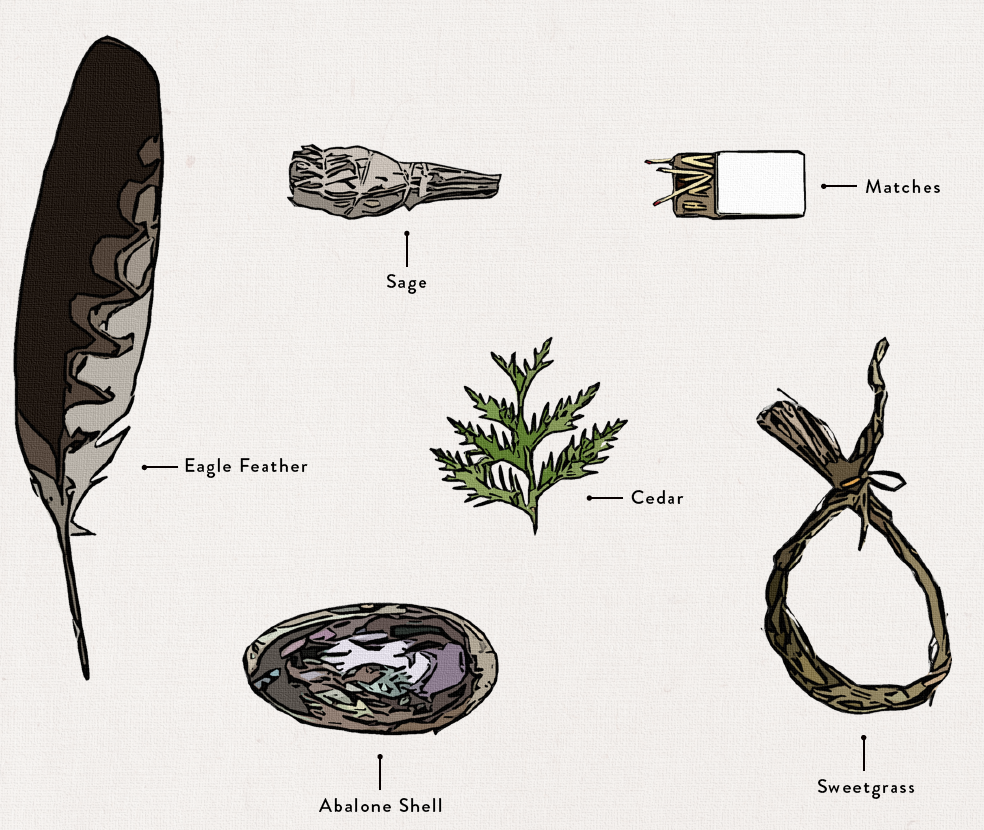Definition and Origin
Treaty 2 Territory- The word “smudging” comes from “smudge,” which is English in origin. However, the term has been used widely to refer to the smudging ceremonies of First Nations peoples, in which sacred herbs and medicines are burned as part of a ritual, or for cleansing or health purposes. Indigenous peoples have their own terms and phrases for smudging. The term for smudging in Anishinaabemowin is ‘nookwez’ which translates as ‘smudge medicinally’.
- I am lighting the smudge: Ni Nookwezige
- I am smudging Ni Nookwez
- Medicines you smudge with: Nookwezigaan
It is important to note that smudging is a cultural, not a religious ceremony, practiced by many Indigenous peoples in Canada and in many other parts of the world. Although practices may differ, smudging is used for medicinal purposes, as well as, for spiritual ceremonies. This practice involves prayer or sending messages while the burning of sacred medicines, such as sweetgrass, cedar, sage and tobacco. While colonization has suppressed such traditions, the practice of smudging has survived to the present day.

Practice
Although different nations have their own specific smudging traditions, they usually share certain teachings. For example, all smudging ceremonies require some sort of vessel to carry the medicines, such as a metal pan, a shell, or a smudge stick. The medicines produce smoke that is said to have healing powers and carry the prayers of the people to the Creator. The smoke is wafted over the face and body of the person being smudged, either by a feather (ideally an eagle feather) or by hand. The person guides the smoke towards their head and body with their hands to restore the physical self. Many people smudge parts of the body, such as the head, feet, back and sensory organs, smudging provides the whole body with a renewed sense of self. According to some teachings, smudging the back allows for the release of troubles that weigh one down. Smudging the ears, eyes and mouth focuses on bringing and sending of positive thoughts and actions. Respect for the self and for others, including the earth forms the basis for smudging.
Smudging Prayer
I wash my hands in the smoke from the sweet smudge so that they may always be constructive – never idle… And so, I can reach out to others with softness, kindness, and good intentions.
I bring the smoke over my head and down my back to lighten my troubles and bring clarity of purpose.
I smudge my eyes so that I will see good things in people and learn from them… and so that I will see bad things in people and learn to be better.
I smudge my ears so that I will listen carefully to others, learn from what they say and become someone that they trust.
I smudge my mouth so that I will only say good things to people and learn to choose my words carefully… and so I will live in kindness and with respect.
I bring the smoke towards my chest to surround my heart…so that what has been damaged can heal and what pain is to come will make me stronger and grow in a good way.
I smudge my feet so that I might walk softly on Mother Earth.
When a room or place is being smudged, the smoke is directed around the location, while the person conducting the ceremony prays for the negative energy to leave and for positive energy to remain. The ashes of the burned medicines are not put into the garbage; rather, they are put outside, onto the earth, to signify that negative energy is placed outside of our lives.
Smudge or cleansing ceremonies are frequently led by an elder, knowledge keeper or spiritual leader, though anyone can perform their own smudging ceremonies when they feel the need to remove negative feelings or energy.
DID YOU KNOW?
The Four Directions teachings of the medicine wheel feature significantly in smudging ceremonies. For First Nations peoples, the four elements are represented in parts of the ceremony: fire in the burning of the sacred herbs, earth in the medicines themselves, air in the feather used to fan the smoke or the smoke itself, and water in the vessel to carry the herbs. These medicine gifts of tobacco, sage, sweetgrass and cedar belong in the four quadrants, in the four directions.
Submitted by Renée McGurry, Earth Lodge Development Helper
Website: lodge.fnt2t.com
